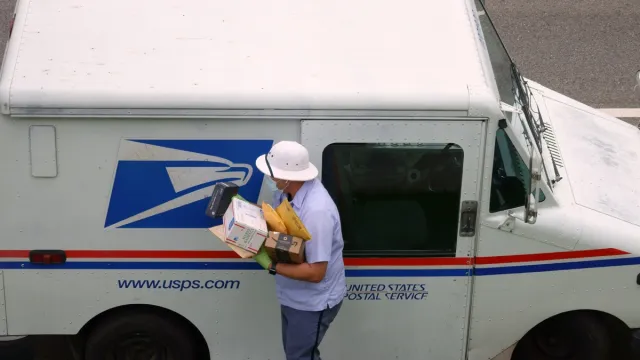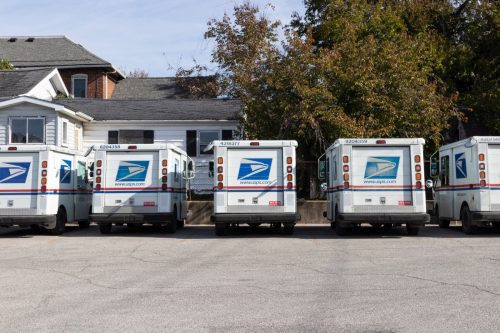All the Changes USPS Is Making to Your Mail This Year

Whether you’re waiting for a check in the mail or need to ship a package across the country, there are certain standard services we’ve all come to expect from the U.S. Postal Service (USPS). But the agency is hardly on solid footing, as it has been battling a number of challenges over the past few years, from staffing shortages to financial shortcomings. These problems have trickled down to customers, leading to a considerable amount of complaints about mailing delays and increased costs.
The situation has become so dire that President Joe Biden signed the Postal Service Reform Act on April 6, which will provide nearly $50 billion in relief to the USPS over the next 10 years as an attempt to help the agency get back on track. But even before this bill was signed, the Postal Service has been making a number of adjustments to its service to try to combat these ongoing issues. Read on to learn all the ways the USPS has already changed and is planning to change your mail service this year.
READ THIS NEXT: USPS Just Issued This “Uncomfortable” New Warning to All Customers.
USPS slowed down mail deliveries in October.

If you’ve felt like some of your mail deliveries have gotten slower over the past few months, you’re not imagining things. On Oct. 1, 2021, the Postal Service implemented “new service standards” for First Class Mail and Periodicals. “A service standard is the number of days between the acceptance and delivery of a piece of mail that the Postal Service considers to be timely delivery,” the agency explained on its website.
In other words, the USPS has slowed down the timeframe in which it has to deliver some of your mail. The agency increased its time-in-transit standards by one or two days for First-Class Mail and Periodicals that are traveling longer distances. “The current service standards are challenging to meet reliably. Adjusting the service standards will provide customers with more stable and realistic expectations,” the USPS said when it announced the change.
The agency added that as a result of these new standards, customers should adjust by mailing certain items earlier. “If it would take you more than a day to drive your mail to its destination, make sure to give your long-distance mail some extra time to travel with USPS,” the Postal Service recommended.
It also got rid of some of its shipping options at the beginning of 2022.

As soon as the new year rolled in, the USPS decided to pare down your shipping options. The agency first announced in August that it would be phasing out its Priority Mail Prepaid Flat Rate Stamped Envelope in 2022. “The envelope, which is only sold online … will remain available until January or while supplies last,” the Postal Service said at the time.
By Jan. 12, the envelopes were no longer available to purchase on the USPS website, eSeller 365 reported. The agency said the decision to discontinue this shipping option was largely due to the fact that demand for the product had tanked. “The Postal Service is discontinuing the envelope because orders have steadily declined over the years, while production and fulfillment costs continued to rise,” the USPS said.
READ THIS NEXT: If You Get an Email From the USPS With These 3 Words, Don’t Click on It.
The Postal Service implemented new shipping fees in April.

One of the most recent USPS changes has impacted the cost to ship certain certain packages. On April 3, the Postal Service introduced two new shipping surcharges: Nonstandard Fees and the Dimension Noncompliance Fee. According to the Federal Register, the new fees affect customers trying to ship certain domestic retail and commercial mail that fall into one of the following categories: Priority Mail Express, Priority Mail, First-Class Package Service, USPS Retail Ground, and Parcel Select.
With the Nonstandard Fee, the surcharge starts at $4 for any package longer than 22 inches but less than 30 inches. For packages over 30 inches in length, the fee goes up to $15. You will also have to pay an additional $15 if your package is greater than 2 cubic feet in volume. And the Dimensional Noncompliance Fee is targeted toward customers who try to get out of paying Nonstandard Fees. With this new fee, you will be charged $1.50 for packages that are greater than one cubic foot or longer than 22 inches if you did not provide dimensions or if they are incorrect, per the USPS.
The agency slowed down deliveries again in May.

After its initial slowdown in Oct. 2021, the USPS just curtailed the delivery time for even more mail. The Postal Service announced in April that it was planning to extend the delivery timeframe for almost one-third of its small, lightweight packages by introducing new service standards for its First-Class Packages. This change went into effect on May 1 and with it, the transport time for 32 precent of these packages increased by one or two days.
“Modifying these service standards will allow for additional transport time for long-distance package deliveries and increased network efficiencies,” the USPS said when announcing the change.
On the other hand, the service standard for 64 percent of package volume remained unchanged, while 4 percent of its First-Class Package Service volume actually now has a shorter transport time of two days instead of three days. The agency also got rid of an extra delivery day for Priority Mail ground deliveries, which was put in place in April 2020 as a way to give the USPS extra time for deliveries in light of global supply chain issues and employee availability amid the COVID pandemic.
RELATED: For more up-to-date information, sign up for our daily newsletter.
USPS recently filed plans to raise other prices.

The Postal Service’s plans to increase costs in 2022 aren’t stopping at just a few new fees, however. On April 6, the USPS filed a notice with the Postal Regulatory Commission (PRC), announcing plans to raise First-Class Mail prices by 6.5 percent. This hike includes increasing the cost of the First-Class Mail Forever stamp from 58 cents to 60 cents.
The proposed changes also include increasing the single-piece letter additional ounce price to 24 cents, the metered mail 1-ounce price to 57 cents, a postcard stamp price to 44 cents, and the price of one-ounce letters mailed to other countries to $1.40 cents. All of the new costs will go into effect on July 10 “if favorably reviewed by the PRC,” the USPS said.
When asked during an interview about the reasoning behind the proposed price increase, Postmaster General Louis DeJoy said, “Because we need money,” Reuters reported.
READ THIS NEXT: USPS Is Now Warning Customers About This Major Mail Problem.
The Postal Service is getting rid of one of its shipping services soon.

Another upcoming change from the USPS could impact those who ship fragile packages with the postal agency. According to an April 20 notice from the Federal Register, the Postal Service is planning to getting rid of its Special Handling-Fragile service this summer. This change is also set to go into effect on July 10.
The Special Handling-Fragile service was initially implemented as a way for the agency to provide “additional care” for certain packages like those including “plants, animals, and sensitive items and merchandise.” But the USPS has decided to bring an end to this shipping option after an investigation revealed that “operational procedures do not support the preferential handling” of items shipped with this service, according to the Federal Register notice.
“The Postal Service continues to strive to build and maintain a loyal relationship with its customers and provide products and services with integrity,” the notice reads. “However, with the execution gaps that currently exist with Special Handling-Fragile, the Postal Service believes it is in the best interest to discontinue the Special Handling-Fragile extra service.”
The agency also plans to make other shipping changes in July.

The Postal Service is also planning to make a second shipping change in the month of July—this time impacting the zones it uses for shipments. On May 9, the agency announced that it will soon be updating “the way the distance between origin and destination ZIP Codes is calculated to determine zone assignment.”
The USPS separates its shipping zones into nine different zone ranges, according to the Shipping School. Anything being shipped no more than 50 miles is categorized as Zone 1, while anything shipped 1,801 miles or more falls into Zone 8. The last range—Zone 9—is “designated for freely associated states,” which covers things shipped to U.S. territories. But starting July 10, the Postal Service will start using the distances between 3-digit ZIP Codes to determine zones rather than using the distance between origin and destination plants.
“The Postal Service is removing the dependency on plant location from the zone calculation to provide more stable zone calculations for our customers,” USPS spokesperson David Coleman told eCommerce Bytes. “In most instances, this will not make a difference in price because for most ZIP Code pairs the zone is not changing. For some 3-digit ZIP Code pairs, the zone will change, going either up or down. It depends on distance from the plant and the orientation between the plant and the ZIP Code.”
READ THIS NEXT: 5 Reasons Your Mail Isn’t Showing Up, USPS Warns.